In Norse mythology, there are many jotnar (the evil/antagonistic giants) who play roles in various myths. However, there are only a few who have their own poems in the Poetic Edda like Hymir does with the Hymiskvitha. As such, you could say he is one of the central, or main jötuns.
Furthermore, Hymir is at the center of one of the great unanswered mysteries of Norse mythology (there are a few), namely who is Tyr’s father. The question arises from some conflicting sources that name both Hymir and Odin as his father. Moreover, Hymir seems to really loath his own son so it seems fair to assume there is something amiss.
In this post I will discuss both the myths in which Hymir plays a part as well as him being Tyr’s father or not.
Hymir Key Facts
| Parents | Unnamed |
| Partners | Hroðr (Hroth), possibly, but not certain about this |
| Siblings | None known |
| Offspring | Týr, Aesir god of justice, unnamed daughters |
| Tribe | Jötun |
| Old Norse name | Hymir |
| Other names | None known |
| Associated Powers | Strength, stone head |
| Ass. With | Giant Cauldron for Brewing, Thor’s fishing trip |
Name and Etymology
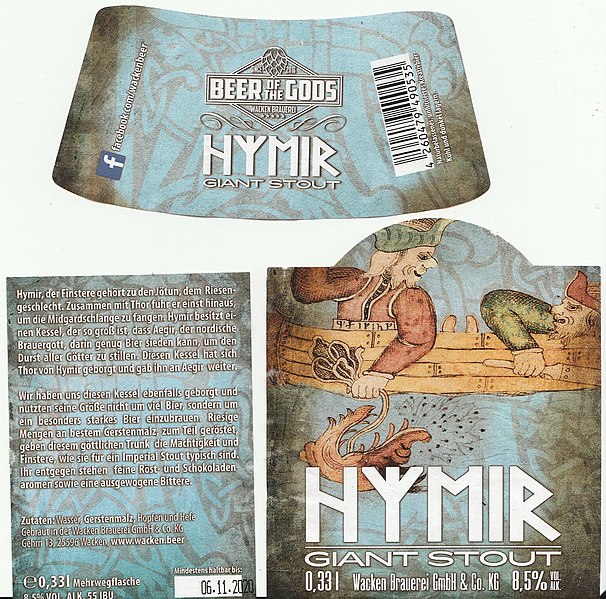
The name Hymir, consistent across Old Norse texts, isn’t easy to translate or find a meaning for. I’ve come across different speculative meanings of the name, but none that I could actually make sense of or find reason to repeat.
One thing worth mentioning though is that there are at least a couple of instances where his name is used in kennings for jotnar. This only shows how well known he likely was in the Viking Age.
Hymir’s Origins and Family
Unlike most of his jötun kinsmen, Hymir’s origins are veiled in the mists of myth, with scant details on his lineage. Neither in the Hymiskvitha, or in any other ancient text are we given any mention of his ancestors. All jotnar are descendants of Ymir naturally, but Hymir came to the world many generations later.
Family and Relationships
While we don’t know much about his parents, his mother is actually mentioned in the Hymiskvitha along with his wife, who is mother to Tyr. This is found in verse eight.
- The youth found his grandmother, whom he greatly loathed,
And she had nine hundred heads;
But the other, fair with gold, came out,
And the bright-browed one brought beer to her son.
An interesting point here is how diverse the descriptions and looks of the jötuns are. Some, like Tyr’s grandmother, are clearly what we in Norway would call a troll, with her nine hundred heads. Tyr’s mother on the other hand is described as “fair” and all golden. In the translation above she is “fair with gold” which sounds like she was wearing jewelry.
However from the original Old Norse I see it should be all-golden, like a blond, golden goddess. She seems to be much more like Gerdr, Freyr’s jötun wife. She was so beautiful Freyr fell in love at first sight.
Hymir’s Daughters
In another mention, this time in the Poetic Edda poem Lokasenna, we also learn that Hymir has daughters. They are never mentioned elsewhere so likely they never played part in any great stories. The verse in Lokasenna mentioning them goes like this:
Loki spoke:
34. “Be quiet, Njord! You were sent eastward as a hostage to the gods. And the daughters of Hymir had their way with you when they used your mouth.”
This obviously refers to how Njörd came to live among the Aesir, as part of a hostage exchange after the Aesir-Vanir war. Him having had some sort of run-in with Hymir’s daughters though is another one of the Old Norse stories that are sadly lost.
Having read all the Old Norse poems I can only imagine that whatever the daughters of Hymir did to Njörd, it was likely unpleasant. I’m not going to spell it out here, but there are several instances where jötun women are described as using all manner of bodily fluids when meeting any of the gods.
Is Hymir Tyr’s Father or Not
When it comes to Hymir’s family, the most interesting question really is his relationship with his son Tyr. The reason why this is question is because in the Skaldskaparmál, Snorri states that Tyr is son of Odin. This reference is found in Skaldskaparmál, chapter nine.
IX – On how to periphrase Tyr
“How should one periphrase Týr? By calling him the One-handed God, and Fosterer of the Wolf, God of Battles, Son of Odin.
However, this is contradicting the much older Poetic Edda poem Hymiskvitha in which Tyr is clearly Hymir’s son.
I believe that this is a case of Snorri sometimes taking some artistic liberties in his writing, and possibly not spelling out all the nuances. Actually, I think both are right, in a sense.
Odin has a long story of charming, tricking or forcing women into having sex with him, also some jötun women. Tyr’s mother is described as a beautiful woman so that does make it more likely. I believe that Tyr was the product of an affair, where Hymir’s wife “stepped out” and had sex with Odin. Then Tyr would have grown up in Hymir’s house, as his son, but possibly both Odin and Hymir knew better.
Furthermore, this might explain why Tyr left them and lived among the Aesir as an Aesir god, and why Hymir seems less than pleased about seeing him. Also, but this is more speculative, it could explain the poor relationship between Tyr and his grandmother, if she is indeed Hymir’s mother.
Role and Depiction
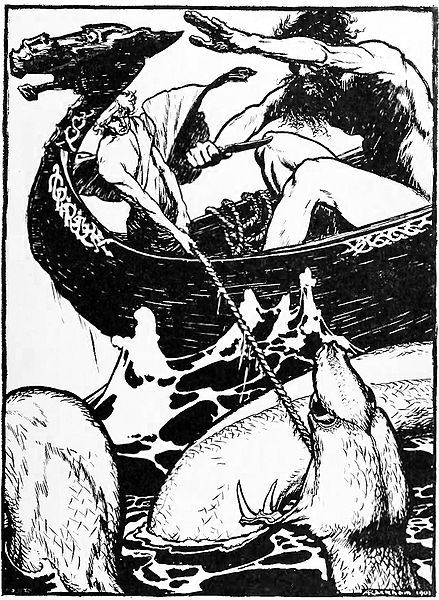
There is no question that Hymir is depicted as an immensely strong, fierce and violent jötun with a short temper. When he learns that Thor and Tyr are in his house, his fierce glance alone is enough to break what I understand to be a roof beam.
- “See where they sit under the gable!
They hide behind the beam.”
At the giant’s glance, the beam broke,
And the mighty pillar fell to pieces.
However, as is often the case in the stories of Old Norse mythology, he is still a good host, no matter their animosity. Tyr and Odin are welcomed into the house and they put on a feast where Thor eats two giant oxen himself.
The threat of violence is never far away though when it comes to the Aesir and jotnar, and this is evident in one of the last verses. Then, Thor and Tyr have left with the cauldron (kettle) they came to fetch. However, looking back over his shoulder, Thor can see the jotnar coming after them.
- He stood and cast the kettle from his back,
And wielded Mjollnir, the lover of murder;
So he killed all the whales of the waste.
That was likely the end of that, and the end of Tyr’s father, adopted or not. Since the role of the jotnar in Old Norse myths is as representing chaos and evil, killing all of them needs no further justification.
Myths and Mentions of Hymir
Naturally, the Hymiskvitha found in the Poetic Edda is the main source for all we know about Hymir. It is more than likely also the source Snorri Sturluison used when he wrote about Thor’s fishing trip in Gylfaginning. In it, Snorri borrows only the part about the fishing trip, and presents it as its own story, omitting the quest for the cauldron etc.
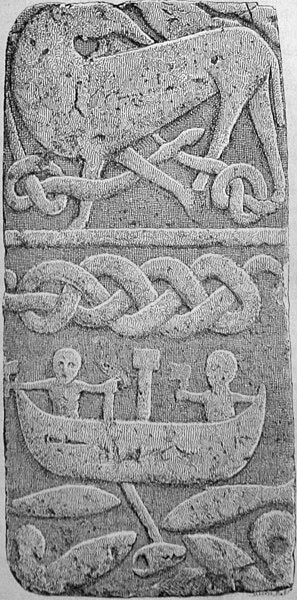
In addition to these two larger stories, there are some mentions of Hymir here and there in other of the ancient texts.
Hymiskvitha – Poetic Edda
As I mentioned already, the Hymiskvitha is the main source for all our knowledge about the jötun Hymir, his family and ultimate demise.
As this is a poem found in the Poetic Edda, which is much older than the Prose Edda, this is seen as a reliable source. Manuscripts written later, are quite often adapted, or written through the lens of a Christian describing old pagan myths.
Lokasenna – Poetic Edda
One of the more interesting mentions is maybe found in the Lokasenna. Here he is only included since there is a mention of Hymir’s daughters. Without any other mention of this story, where Njörd somehow is humiliated by Hymir’s daughters, we’ll never know what happened.
Loki spoke:
34. “Be quiet, Njord! You were sent eastward as a hostage to the gods. And the daughters of Hymir had their way with you when they used your mouth.”
Gylfaginning – Prose Edda
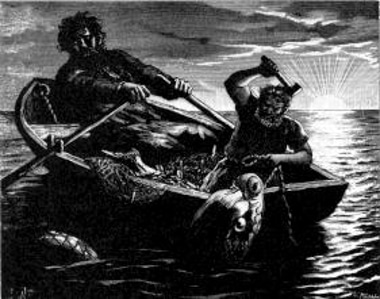
The Gylfaginning is part of Snorri Sturluson’s Prose Edda, and as such seen as less reliable a source than older poems. This is evident when reading about Hymir in it, where Snorri only includes the story of Thor and Hymir going out fishing. This is only a part of the whole story found in Hymiskvitha, but Snorri presents it as its own story.
Below is the beginning section of that story as its found in Gylfaginning, which illustrates my point about how it’s adapted.
He went out of Midgard in the guise of a young man, and came in the evening to a giant by name Hymir. Thor tarried there as a guest through the night. In the morning Hymir arose, dressed himself, and busked himself to row out upon the sea to fish.
Here Thor is seemingly just wandering around Jotunheim, and happens to meet Hymir.
Skáldskaparmál
Hymir is also mentioned twice in the Skáldskaparmál, but then in reference to others, once as part of kennings for Thor, and in another for another jötun, as a kinsman of Hymir.
From Skáldskaparmál chapter IV – On how to periphrase Thor.
Thus Úlfr sang further:
The very mighty Slayer
Of the Mountain-Man brought crashing
His fist on Hymir’s temple:
That was a hurt full deadly.
In this verse by the skald Úlfr, Thor is said to have smashed his fist into Hymir’s temple, killing him. In the Hymiskvitha however Mjolnir seems to kill all the jotnar.
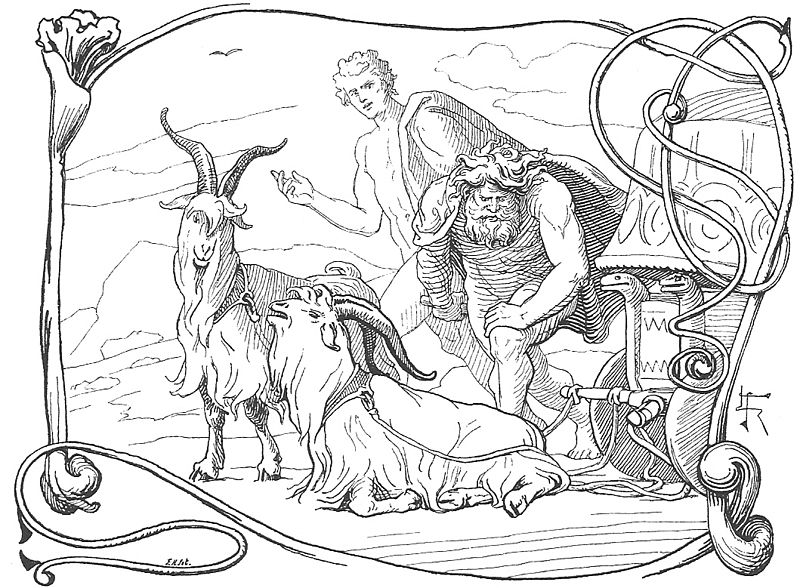
In a later chapter in Skaldskapramál, XXII – On how to periphrase Idunn, there is another mention of Hymir. Here it is only used as a kenning for the jötun Thjazi, who threatens Loki into abducting the goddess Idunn. Thjazi is referred to as “Hymir’s Kinsman”. In the story of the kidnapping of Idunn, Loki both aids in abducting her, then frees her, leading to the death of the jötun Thjazi. Seeking retribution for this, his daughter Skádi, ends up marrying Njörd.
Then Hymir’s Kinsman ordered
The crafty god, pain-maddened,
To wile to him the Maiden
Who guarded the Aesir’s age-cure;
Before long the necklace-robber,
Brísinga’s thief, lured slyly
The Dame of Brunnakr’s brooklet
Into the Base One’s dwelling.
Nafnaþulur – List of Names
Hymir’s presence in the Nafnaþulur, a catalog of names within the Skaldskaparmal, alongside other giants, underscores his significance within the Norse mythological framework. This is the last part of Snorri’s Skaldskaparmál. However, it is usually regarded as more reliable as it is likely written down as reference and more or less free from artistic liberties.
Here Hymir is listed among all the other giants found listed in two verses.
- Hraðverkr, Hrökkvir,
and Hástigi,
Hræsvelgr, Herkir
and Hrímgrímnir,
Hymir and Hrímþurs,
Hvalr, Þrígeitir,
Þrymr, Þrúðgelmir,
Þistilbarði.
Frequently Asked Questions
Hymir is distinguished by his association with the sea and his role in the myth involving his cauldron, symbolizing the depth of wisdom and resources.
While not explicitly described as wielding specific powers, Hymir’s strength and his control over the formidable creatures of the sea, as demonstrated in his fishing expedition with Thor, highlight his dominion over the ocean’s depths.
The cauldron symbolizes the vast resources and wisdom of the sea, as well as the interdependence between the gods and the jötnar.
The expedition ended with Thor catching the Midgard Serpent, Jörmungandr, showcasing the god’s strength and the perilous nature of the challenges posed by Hymir’s realm.
Hymir’s myths teach about the respect for the natural world, the value of wisdom and resources, and the complex relationships between forces of nature and the divine order.
Featured Image Credit: Lorenz Frølich, Public domain, via Wikimedia Commons
